
Sights • Localities • Cuisine • Tours • Hotels
Sicilian Wines
Related: Wine Renaissance • Wine Country •
Novello • Aristocratic Vintners •
Cuisine • Olive Oil •
Food & Wine Tours
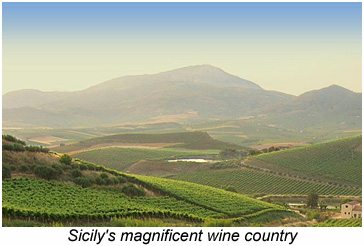 One of Europe's oldest viticultural
regions still offers some pleasant
surprises. Sicily's oenological history is an ancient one, dating from the time when the
island was part of Magna Graecia. One usually associates fine
wines with western Sicily or the areas near Mount Etna, but many new wineries
have sprung up across the island. Sicilian oeniculture is not just varietals.
Sicily's vintage wines are a magical creation, and many of the island's
traditional wines and spirits are famous far beyond its shores. Several
boast denomination of origin (appellation). Sicily has its own table and dessert wines,
and a number of regional liqueurs.
One of Europe's oldest viticultural
regions still offers some pleasant
surprises. Sicily's oenological history is an ancient one, dating from the time when the
island was part of Magna Graecia. One usually associates fine
wines with western Sicily or the areas near Mount Etna, but many new wineries
have sprung up across the island. Sicilian oeniculture is not just varietals.
Sicily's vintage wines are a magical creation, and many of the island's
traditional wines and spirits are famous far beyond its shores. Several
boast denomination of origin (appellation). Sicily has its own table and dessert wines,
and a number of regional liqueurs.
The magic is in the fertile soil and Sicily's long, cloudless summers – with humidity but virtually no rain from June until harvesting in late August – two factors which make Sicilian vintages remarkably consistent from year to year.
Marsala • Zibibbo • Primitivo • Liqueurs & Grappa • Moscato & Passito • Malvasia
Nero d'Avola • Varietals • Appellation ('Denomination of Origin')
• Novello & Others
'New' Wines
Marsala
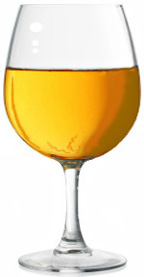 Sicily's most famous
wine, Marsala, was first made in the city of that name
on the western coast by the Woodhouse firm, which also sold Port. Like its
sisters Port and Sherry, Marsala is a fortified wine with an alcohol content
of around twenty percent. It is usually made from native Grillo, Catarratto,
or Inzolia grapes. John Woodhouse established his winery at Marsala in 1796.
Benjamin Ingham founded a competing firm in 1812, followed by Vincenzo Florio,
a Calabrian, in 1832. Larger vintners such as these have always dominated
the Marsala wine trade, though smaller firms have entered the field in recent
years. They've brought a welcome family spirit to the industry, which in
the last two decades had fallen under the aegis of larger corporate entities.
Sicily's most famous
wine, Marsala, was first made in the city of that name
on the western coast by the Woodhouse firm, which also sold Port. Like its
sisters Port and Sherry, Marsala is a fortified wine with an alcohol content
of around twenty percent. It is usually made from native Grillo, Catarratto,
or Inzolia grapes. John Woodhouse established his winery at Marsala in 1796.
Benjamin Ingham founded a competing firm in 1812, followed by Vincenzo Florio,
a Calabrian, in 1832. Larger vintners such as these have always dominated
the Marsala wine trade, though smaller firms have entered the field in recent
years. They've brought a welcome family spirit to the industry, which in
the last two decades had fallen under the aegis of larger corporate entities.
For more than a century, Marsala was the equal of Sherry and Madeira, if not Port. By the 1950s, however, it found itself relegated to the kitchen as cooking wine, and competition came from unorthodox quarters, with the introduction in the United States of a watery "California Marsala." In 1986, the Italian Republic's D.O. (denomination of origin or appellation) laws for Marsala were revised to incorporate stricter regulations similar to those which the Portuguese government instituted for Port (a somewhat heavier wine), and Marsala is now resuming its place as a dessert and aperitif wine.
Today's Marsala is often divided into three different standards, namely oro (golden), ambra (amber), and rubino (ruby). Some marsala makers prefer to categorise it according to terms used for Port wine, such as tawny. There are both sweet and dry types, and various categories (of which we'll mention just a few). "Fine" is aged for a minimum of one year, while "Superiore" is aged for a minimum of two years (some vintners age it for three years). "Superiore Riserva" (often simply "Riserva") is a vintage wine aged in wood for four years, and sometimes as long as six. "Vergine" is aged in wood for a minimum of five years (some firms age it in small oak casks for as long as seven years). For cooking, there's even a Marsala made with the addition of egg white (though you probably won't notice this ingredient). Truth be told, there are dozens of kinds of Marsala wine, some unique to certain houses, each meeting particular standards. Some estates age it in oak casks from the 1860s, making your Marsala experience a piece of Sicilian history. (A number of firms produce exceptionally good Marsalas; Florio offers the widest range of types.) Marsala shouldn't be confused with other sweet Sicilian dessert wines of amber colour. Passito, described below, is not a fortified wine.
Some pleasant Marsala liqueurs have also been introduced, though they're difficult to find on the market. Florio makes a fine brandy, and several firms make almond-flavored Marsala, best described as Sweet Marsala with a touch of Amaretto, though it's much more than that. Sicilian egg nog (zabaglione) is made with Marsala.
Zibibbo
Purists will tell you that Zibibbo is a grape variety that can be used to
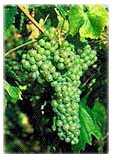 make anything from table wine to
grappa. However, the Zibibbo made commercially by several houses is a strong
wine similar to Marsala but fermented and then partially distilled naturally,
without the addition of spirits. The process differs also in that Zibibbo
is actually made from grapes partially fermented in the sun. It is a very
old process, and Zibibbo, though not the direct precursor of Marsala, derives
from a formula known in the Middle Ages. It is typically slightly lower
in alcohol than Marsala (about fifteen percent compared to eighteen or twenty
percent) and sometimes more robust. The Zibibbo grape is similar to Moscato,
and the wine known as Moscato di Pantelleria Naturale is made mostly from
Zibibbo grapes.
make anything from table wine to
grappa. However, the Zibibbo made commercially by several houses is a strong
wine similar to Marsala but fermented and then partially distilled naturally,
without the addition of spirits. The process differs also in that Zibibbo
is actually made from grapes partially fermented in the sun. It is a very
old process, and Zibibbo, though not the direct precursor of Marsala, derives
from a formula known in the Middle Ages. It is typically slightly lower
in alcohol than Marsala (about fifteen percent compared to eighteen or twenty
percent) and sometimes more robust. The Zibibbo grape is similar to Moscato,
and the wine known as Moscato di Pantelleria Naturale is made mostly from
Zibibbo grapes.
Primitivo
The Primitivo grape is rarely used by itself anymore. Some fascinating genetic
research in California indicates that the grape Americans call Zinfandel
is actually Primitivo, a Sicilian variety that may have been introduced
by the Albanians who settled certain Sicilian communities in the sixteenth
century. It was probably taken to California in the eighteenth century by
Spanish colonists or later by Sicilian immigrants.
Liqueurs &
Grappa
Several liquors unique to Sicily are worthy of mention. Ala, made by Florio,
has a distinct flavor, as does Averna, which is made in Caltanissetta. Fichera,
a newcomer, is made near Mount Etna. There are also several mildly fortified
almond-flavored white wines which, though not suitable for every occasion,
go well with some desserts. Several Sicilian liqueurs are similar to those
produced on the mainland, namely limoncello, from lemons, anisette and amaretto.
There are others, such as the interesting liqueur made from prickly pears
(cactus fruits) and Cynar (from artichokes). Grappa is actually a brandy
distilled from grape seeds and pomace. Dry and high in alcohol, it is usually
white and served as an after dinner drink. In Italy, grappa is often sold
in artistically original clear glass bottles which the distillers commission
specially for this liquor.
Moscato &
Passito
Moscato is difficult to describe. It comes from the Muscat grape, of course,
or from the sub-variety known locally as Moscatello, sometimes with the
addition of Corinto or Zibibbo. Some fine whites can be made from Muscat,
but in Sicily and the nearby islands it is usually rendered as a golden
or light amber dessert wine (popular with biscotti on St Martin's Day), sometimes fortified or even sparkling (spumante).
A few localities are famous for Moscato. Moscato and Moscato Passito are
made by some distinguished wineries on the islands of Pantelleria and Lipari.
As its name implies, Moscato Passito contains Appassito grapes. By tradition, vintners
use a special "dry" process in production of Passito, so semi-dry grapes and even
raisins find their way into the must. Unlike Marsala and Port, to which alcohol may be added, Passito is not a "fortified" wine.
This brings us to the point that Passito refers as much to a winemaking process as to a
specific grape variety. The areas around Siracusa and Noto, in the eastern part of Sicily, also produce fine
Moscato wines.
Malvasia
Malvasia is another white grape used to make a strong varietal that is golden
to amber in color and slightly fortified. Bred from an older grape variety,
Malvasia is grown in northeastern Sicily (near Messina) and on the island
of Lipari, where it is used in the making of a wine somewhat similar to
Moscato.
Nero d'Avola
This hearty red is Sicily's most popular non-fortified varietal, now 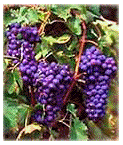 produced by numerous Sicilian wineries. Often compared
to Syrah, it is sometimes blended with other reds but usually allowed to stand on its own. A full-bodied red like
this one is not easily overlooked, and dozens of wineries (including makers
of "new wines") have
introduced this varietal to cash in on a profitable trend. To avoid an overpowering taste, the
flavor of this wine is best when the grapes are placed in
cooled vats at harvest --preferably at night-- to prevent conditions which can lead to premature fermentation. This
technique, however, is employed by very few wineries. (While we're reluctant to endorse
one vintner over another, it's worth mentioning that recent vintages offered by Milazzo and Planeta stand
out from dozens of other Nero d'Avolas we've tasted.)
produced by numerous Sicilian wineries. Often compared
to Syrah, it is sometimes blended with other reds but usually allowed to stand on its own. A full-bodied red like
this one is not easily overlooked, and dozens of wineries (including makers
of "new wines") have
introduced this varietal to cash in on a profitable trend. To avoid an overpowering taste, the
flavor of this wine is best when the grapes are placed in
cooled vats at harvest --preferably at night-- to prevent conditions which can lead to premature fermentation. This
technique, however, is employed by very few wineries. (While we're reluctant to endorse
one vintner over another, it's worth mentioning that recent vintages offered by Milazzo and Planeta stand
out from dozens of other Nero d'Avolas we've tasted.)
Varietal
Wines
Chardonnay, the world's ubiquitous varietal, is present in Sicily, but primarily
from smaller vintners. In Sicily, as well as other parts of Italy, there's
also Chardonnay Grappa. Native varietals are also present in the regional
market and (increasingly) the international one. Inzolia, Cataratto and
Grecanico are pleasant whites. The red Nero d'Avola (following section)
is becoming increasingly popular. Cabernet Sauvignon is also popular, sold
especially by better houses like Tasca (Regaleali). Pinot Bianco has been
made in Sicily for some years. It has a flavor and texture similar to those
of Chardonnay. Pinot Grigio is used to produce wines that are soft and fragrant,
with more color than most other whites, but it's not as popular among Sicilian
vintners as Pinot Bianco. Trebbiano is not usually made into a varietal
wine in Sicily, but this grape is used in certain wines. Frascati ranges
from dry to sweet. It is not, strictly speaking, Sicilian, though these
grapes are grown here. Some of the more important Sicilian grape varieties:
Carricante (Catanese Bianco). A white from the Etna area.
Cataratto Bianco. A white traditional in the Trapani area and used in Marsala wine, characterised by a delicate flavor and medium alcohol level.
Corinto. A light white.
Frappato. Strong red of uncertain origin grown in southeastern Sicily. It is genetically very similar to Gaglioppo (see below).
Gaglioppo. A red of Calabrian origin frequently grown in Sicily. Similar to Frappato.
Grecanico (Greco). A white so-called for its Greek origins. Genetically very similar to the Garganega grown in Veneto.
Grillo. A distinctive white.
Inzolia, Insolia or Anzolia. Used to create dry white table wines, either as a varietal or blended with varieties such as chardonnay.
Malvasia. A muscatel sub-variety used to make the wine of this name, but the term more properly refers to the Moscato grape (see below).
Moscato. Muscat, a traditional variety widely used in Italy, in Sicily associated with the dessert wine of this name, simlilar to Malvasia. The muscatels are one of European winemaking's most widespread grape types.
Nerello. Strong red grown in two varieties, Mascalese and Cappuccino.
Nero D'Avola (also called 'Calabrese'). Hearty red used in some of Sicily's most popular wines.
Perricone (Pignatello). Esoteric, robust red.
Primitivo. Traditional red, probably Balkan in origin, original stock for the "Zinfandel" of California, to which it is genetically identical. Nowadays it is rare in Sicily.
Zibibbo (Moscatellone). White (a variety of Muscat of Alexandria) possibly introduced in Sicily by the Saracen Arabs during the ninth century, used in fortified wines and alone. Sicily's muscatel mainstay.
Denomination
of Origin (appellation)
Purists will tell you that Sicily has but one
traditional wine region.
Today great wines are produced around Sicily. A number of Sicilian wines are defined by denomination of
origin (or "appellation" abbreviated D.O. or D.O.C.) as indicated on our
map of wine regions. This obviously includes Marsala (usually made from
a blend of several grapes), as well as the fortified Moscatos, Passitos
and Malvasias (of which there are various recognised types based both on
location and the grape varieties used), but also wines such as Alcamo, made
in the locality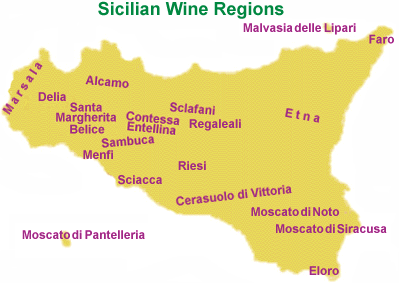 of that name
in the province of Trapani from Catarratto and other grapes, usually Damaschino
or Grecanico. Cerasuolo di Vittoria is made in the province of Ragusa from
Frappato and Calabrese, with the addition of Grosso Nero and Nerello Mascalese.
Etna Whites, produced near Europe's largest active volcano, are usually
made from Carricante and Catarratto, with the addition of Trebbiano or Minnella.
Etna Reds and rosés are made from Nerello. Faro (the name means "lighthouse"),
as its name implies, is typical of the area around Messina. It is a Red
made from two different Nerellos, as well as Nocera and Calabrese, with
the addition of Gaglioppo or Sangiovese. Regaleali, made by Count Tasca,
is not recognised as a D.O. wine, but the vineyards where its grapes
are raised are so well known that this former fief is indicated on some
Sicilian maps, and Regaleali is preferred by most Sicilians to less distinguished D.O. wines
like Alcamo and Etna. This brings us to an important observation, namely
that, for most Sicilian wines (Marsala being an exception), "denomination
of origin," or appellation, is a meaningless designation unrelated to quality. Often,
the system is abused to "dignify" otherwise mediocre wines with
a particular geographic identity as though they were Burgundy or Bordeaux.
of that name
in the province of Trapani from Catarratto and other grapes, usually Damaschino
or Grecanico. Cerasuolo di Vittoria is made in the province of Ragusa from
Frappato and Calabrese, with the addition of Grosso Nero and Nerello Mascalese.
Etna Whites, produced near Europe's largest active volcano, are usually
made from Carricante and Catarratto, with the addition of Trebbiano or Minnella.
Etna Reds and rosés are made from Nerello. Faro (the name means "lighthouse"),
as its name implies, is typical of the area around Messina. It is a Red
made from two different Nerellos, as well as Nocera and Calabrese, with
the addition of Gaglioppo or Sangiovese. Regaleali, made by Count Tasca,
is not recognised as a D.O. wine, but the vineyards where its grapes
are raised are so well known that this former fief is indicated on some
Sicilian maps, and Regaleali is preferred by most Sicilians to less distinguished D.O. wines
like Alcamo and Etna. This brings us to an important observation, namely
that, for most Sicilian wines (Marsala being an exception), "denomination
of origin," or appellation, is a meaningless designation unrelated to quality. Often,
the system is abused to "dignify" otherwise mediocre wines with
a particular geographic identity as though they were Burgundy or Bordeaux.
Novello and Other
Wines
Novello is Sicily's nouveau vintage wine, sold annually just months
after the grapes are harvested and pressed. It is usually robust and fruity.
You're not likely to find it outside Sicily. Sicilian vintners offer a range
of vintage D.O. wines which are not varietals. Though Sicily is not famous
for its sparkling wines, a few are made here. Castelmonte Frizzante, which
is naturally effervescent, is similar to Spumante.
"New" Wines
A number
of small wineries have emerged in recent years, but in many cases they have been producing
wine for decades. In the 1990s, a number of grape producers whose product (grapes, must or wine)
formerly supplied the Marsala industry, or was used to fortify weak French
or northern Italian wines, began to make their own varietal wines for an increasingly sophisticated consumer
market. These wineries now produce some of Sicily's best wines.
However, the recent popularity of Sicilian varietal wines (particularly the reds), and government subsidies for wine producers, has encouraged lawyers, doctors, haberdashers and other non-vintners to make wine for sale, usually with mediocre results. These should not be confused with the wines offered by various small but distinguished family-operated wineries. To outsiders, it's not always an easy distinction.
When Italians speak of "il vino della casa," they usually mean "house wine" in the sense of the wine that a restaurant or farmer has made from local grapes, and images come to mind of strong home-made red wine that tastes like vinegar. Among Italian vintners, however, mention of a "casa" (literally "house") is like a French vintner referring to a chateau, and in Italian aristocratic parlance a "house" is a noble family. Some of Sicily's best houses make excellent wines that don't officially make their way to the consumer market, often because the quantity of a few hundred bottles is not sufficient to justify an advertising or sales campaign. These rare vintage wines are among Sicily's true treasures. Apart from these, some family firms have emerged which offer some exceptional wines.
Home • Sights • Localities • Cuisine • Tours • Hotels
©1999-2025 Best of Sicily Travel, Palermo, Italy. All Rights reserved. You may prefer our desktop site on your tablet or computer.